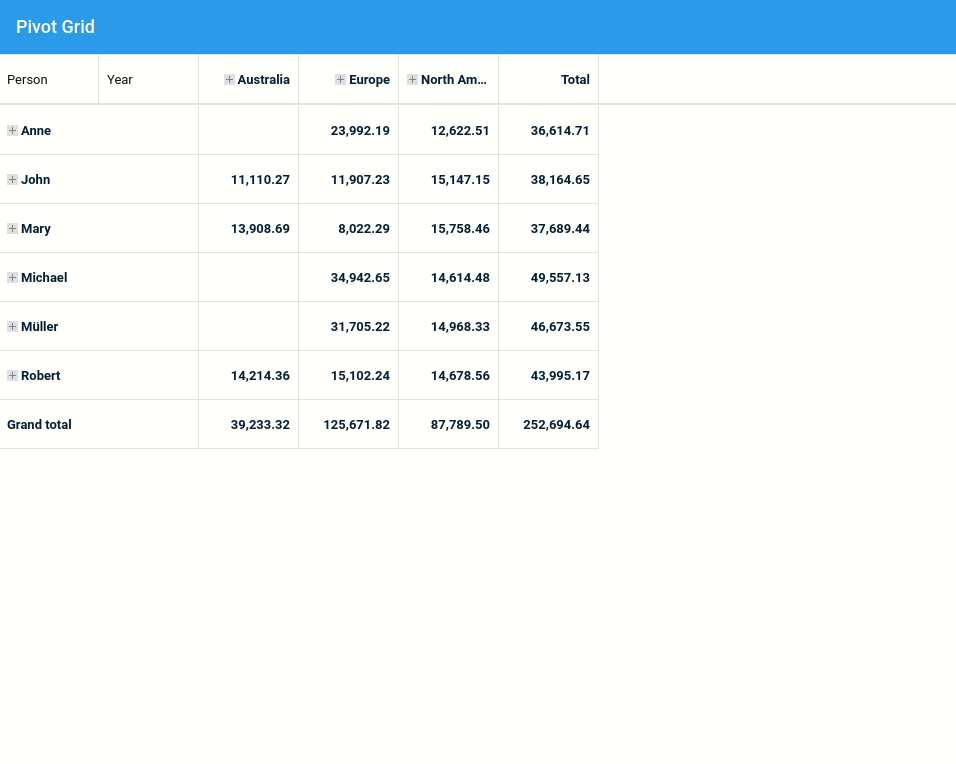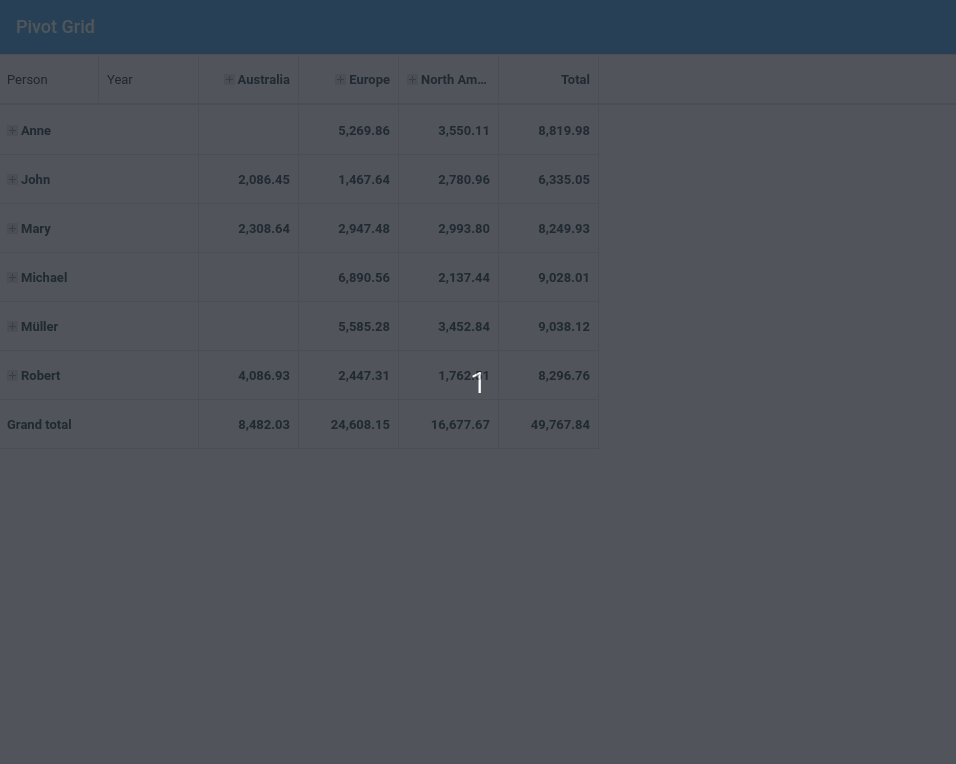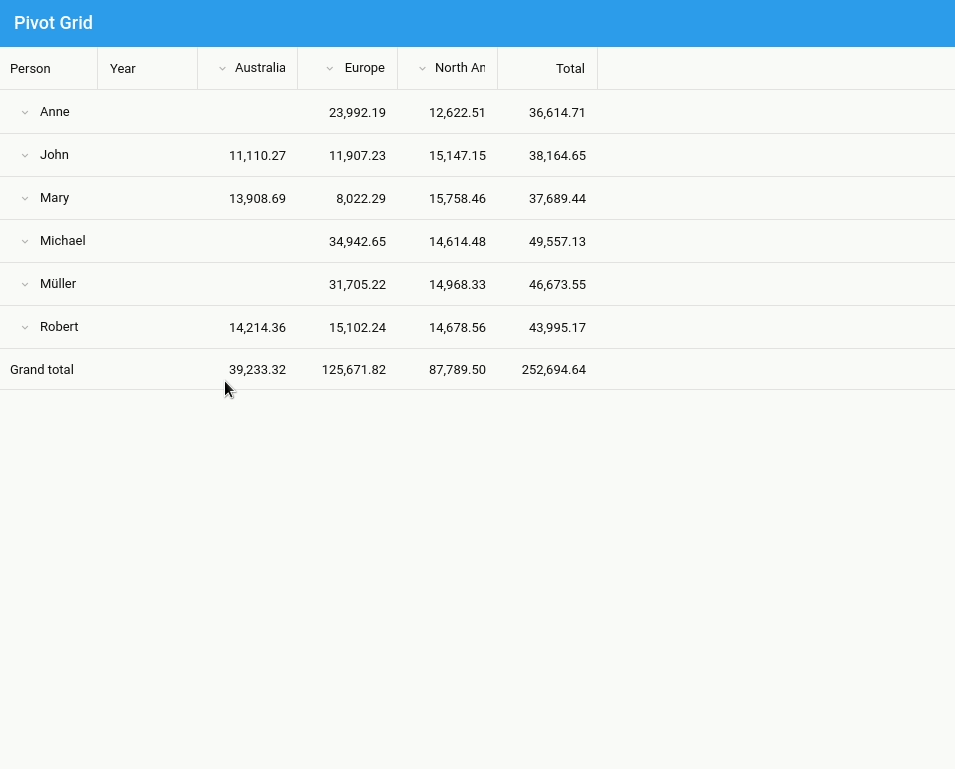5 Powerful Ext JS Pivot Grid Features
The Ext JS Pivot Grid provides a simple way to condense many data points into a format to quickly draw insights and trends from data. In this post we cover 5 powerful Ext JS Pivot Grid features.
1. Axis and Aggregation
The Pivot Grid relies on two pieces that extend the native grid panel:
- Axis: allows you to determine row and column placement
- Aggregation: manages the grouping calculations
These pieces need to be defined on the pivot matrix object used by the Pivot Grid.

How to:
1. Create a Pivot Grid with “matrix” object
Ext.define('Fiddle.view.pivot.Grid', {
extend: 'Ext.pivot.Grid',
xtype: 'configurable-pivot-grid',
controller: 'pivotgrid',
title: 'Pivot Grid',
matrix: {
store: {
type: 'sales'
}
}
});
2. Add axis configuration
matrix: {
store: {
type: 'sales'
},
leftAxis: [{
dataIndex: 'person',
header: 'Person'
},{
dataIndex: 'year',
header: 'Year'
}],
topAxis: [{
dataIndex: 'continent',
header: 'Continent'
}, {
dataIndex: 'country',
header: 'Country'
}]
}
3. Add aggregation configuration
matrix: {
store: {
type: 'sales'
},
leftAxis: [{
dataIndex: 'person',
header: 'Person'
},{
dataIndex: 'year',
header: 'Year'
}],
topAxis: [{
dataIndex: 'continent',
header: 'Continent'
}, {
dataIndex: 'country',
header: 'Country'
}],
aggregate: [{
dataIndex: 'value',
header: 'Total',
aggregator: 'sum'
}]
}
Sencha Fiddle:
Many in-built methods are available such as sum, average, min and so on but it is possible to define a custom method to aggregate data:
aggregator: 'myOwnFn'
2. Filtering
- Filtering by label
Filtering to display the year 2016.

leftAxis: [{
dataIndex: 'person',
header: 'Person'
}, {
dataIndex: 'year',
header: 'Year',
filter: {
type: 'label',
operator: '=',
value: 2016
}
}]
Sencha Fiddle:
- Filtering by value
Filtering to display the 3-best year
matrix: {
store: {
type: 'sales'
},
aggregate: [{
dataIndex: 'value',
header: 'Total',
aggregator: 'sum',
id: 'agg',
}],
leftAxis: [{
dataIndex: 'person',
header: 'Person'
}],
topAxis: [{
dataIndex: 'year',
header: 'Year',
filter: {
type: 'value',
operator: 'top10',
topType: 'items',
topOrder: 'top',
dimensionId: 'agg',
value: 3
}
}]
}
Sencha Fiddle:
3. Multiple Grand Totals
With a Pivot Grid it’s possible to add multiple grand totals.
How to:
listeners: {
pivotbuildtotals: function (matrix, totals) {
var dataAvg = {},
dataMax = {};
Ext.Array.each(matrix.model, function (field) {
var result,
agg;
if (field.col && field.agg) {
agg = matrix.aggregate.getByKey(field.agg);
result = matrix.results.get(matrix.grandTotalKey, field.col);
if (result && agg) {
dataAvg = result.calculateByFn(
'totalavg',
agg.dataIndex,
Ext.pivot.Aggregators.avg);
dataMax = result.calculateByFn(
'totalmax',
agg.dataIndex,
Ext.pivot.Aggregators.max);
}
}
});
totals.push({
title: 'Grand total (avg)',
values: dataAvg
}, {
title: 'Grand total (max)',
values: dataMax
});
}
}
Sencha Fiddle:
4. Range Grouping
How to:
{
dataIndex: 'year',
header: 'Year',
grouperFn: function (record) {
var dataIndex = this.dataIndex,
recIndex = record.get(dataIndex);
if (recIndex >= 1980 && recIndex < 1990) return "80'"; if (recIndex >= 1990 && recIndex < 2000) return "90'"; if (recIndex >= 2000 && recIndex < 2010) return "00'";
return 'Rest';
}
}
Sencha Fiddle:
5. Drill Down

How to:
Ext.define('Fiddle.view.pivot.Grid', {
extend: 'Ext.pivot.Grid',
xtype: 'configurable-pivot-grid',
controller: 'pivotgrid',
title: 'Pivot Grid',
//Add drill down plugin
plugins: {
pivotdrilldown: true
},
matrix: {
/* Matrix configuration */
}
});
Sencha Fiddle:
Build Your Pivot Grid with Ext JS 7.2
The free 30-day trial of Ext JS 7.2 provides full access to the product features. Get started today and see how you can build a powerful pivot grid to make insights from data more apparent.

Every software project begins with a choice that reverberates through its entire lifecycle: which development…

Building software for regulated industries demands more than functional code. Healthcare organizations must protect patient…

The Ext JS Data Grid is widely regarded as one of the most feature‑rich and…









